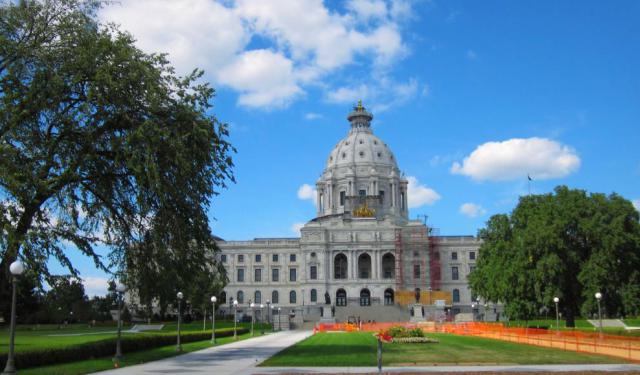Malcolm Moos Health Sciences Tower, Minneapolis
Moos Tower: the campus giant that sparks as many opinions as it does glances upward. With 17 floors, a height of 853 feet, and an exposed aggregate concrete façade, it’s the University of Minnesota’s tallest building-and, let’s face it, one of its least visually beloved. Yet behind its stark appearance lies a story rooted in 1970s university politics and architectural trends.
Conceived by The Architects Collaborative of Cambridge, Massachusetts, the building was completed in the early 1970s and named for Malcolm Moos, a political scientist and the University’s president at the time. Moos Tower is a bold example of brutalism, a design movement that embraced unadorned materials and fortress-like forms. Back then, brutalist architecture was all the rage-intended to stand out in the urban landscape and project strength during a time of societal unrest, including the civil rights era and anti-Vietnam War protests. For a campus that had just witnessed major student demonstrations in May 1972, the solid, uncompromising aesthetic of Moos Tower mirrored the tense and uncertain mood of the times.
Brutalism also offered practical benefits. The raw, utilitarian design allowed for flexibility-interior walls can be shifted to adapt to changing healthcare and academic needs. While it may not win any beauty contests, the building functions well as a medical and educational hub, serving its purpose without frills. In that sense, it’s a true product of its era: unyielding, pragmatic, and a little intimidating. Like it or not, it remains a landmark and a piece of architecture that, for better or worse, has stood the test of time.
Conceived by The Architects Collaborative of Cambridge, Massachusetts, the building was completed in the early 1970s and named for Malcolm Moos, a political scientist and the University’s president at the time. Moos Tower is a bold example of brutalism, a design movement that embraced unadorned materials and fortress-like forms. Back then, brutalist architecture was all the rage-intended to stand out in the urban landscape and project strength during a time of societal unrest, including the civil rights era and anti-Vietnam War protests. For a campus that had just witnessed major student demonstrations in May 1972, the solid, uncompromising aesthetic of Moos Tower mirrored the tense and uncertain mood of the times.
Brutalism also offered practical benefits. The raw, utilitarian design allowed for flexibility-interior walls can be shifted to adapt to changing healthcare and academic needs. While it may not win any beauty contests, the building functions well as a medical and educational hub, serving its purpose without frills. In that sense, it’s a true product of its era: unyielding, pragmatic, and a little intimidating. Like it or not, it remains a landmark and a piece of architecture that, for better or worse, has stood the test of time.
Want to visit this sight? Check out these Self-Guided Walking Tours in Minneapolis. Alternatively, you can download the mobile app "GPSmyCity: Walks in 1K+ Cities" from Apple App Store or Google Play Store. The app turns your mobile device to a personal tour guide and it works offline, so no data plan is needed when traveling abroad.
Malcolm Moos Health Sciences Tower on Map
Sight Name: Malcolm Moos Health Sciences Tower
Sight Location: Minneapolis, USA (See walking tours in Minneapolis)
Sight Type: Attraction/Landmark
Guide(s) Containing This Sight:
Sight Location: Minneapolis, USA (See walking tours in Minneapolis)
Sight Type: Attraction/Landmark
Guide(s) Containing This Sight:
Walking Tours in Minneapolis, Minnesota
Create Your Own Walk in Minneapolis
Creating your own self-guided walk in Minneapolis is easy and fun. Choose the city attractions that you want to see and a walk route map will be created just for you. You can even set your hotel as the start point of the walk.
Minneapolis Introduction Walking Tour
Minneapolis is a major city in Minnesota, straddling the Mississippi River. Together with neighboring Saint Paul, the state capital of Minnesota, it forms the metropolitan area collectively known as the "Twin Cities."
Before European settlement, the site of Minneapolis was inhabited by Dakota people. The settlement was founded along Saint Anthony Falls - the only natural waterfall on... view more
Tour Duration: 2 Hour(s)
Travel Distance: 4.2 Km or 2.6 Miles
Before European settlement, the site of Minneapolis was inhabited by Dakota people. The settlement was founded along Saint Anthony Falls - the only natural waterfall on... view more
Tour Duration: 2 Hour(s)
Travel Distance: 4.2 Km or 2.6 Miles
Saint Paul Introduction Walking Tour
Saint Paul is a fantastic example of a city that has grown through a diverse range of cultures. The location near the Mississippi River helped make what would later become the city a significant center of local trade. The Dakota Sioux tribe were among the earliest residents, and European settlement that included French-Canadian fur traders and Catholic missionaries occurred during the 1830s to... view more
Tour Duration: 2 Hour(s)
Travel Distance: 3.4 Km or 2.1 Miles
Tour Duration: 2 Hour(s)
Travel Distance: 3.4 Km or 2.1 Miles
Historical Churches
The "City of Lakes”, Minneapolis, doesn't pride itself solely on the lakes. In fact, you will be amazed by how many churches, cathedrals, and other places of worship are found throughout the city. These sacred structures have played a significant role in the development of Minneapolis and continue to serve as pillars of faith and community. Let's take a look at some of the most... view more
Tour Duration: 1 Hour(s)
Travel Distance: 2.8 Km or 1.7 Miles
Tour Duration: 1 Hour(s)
Travel Distance: 2.8 Km or 1.7 Miles
University of Minnesota - Minneapolis Campus Walking Tour
Founded in 1851, seven years before Minnesota became a state, the University of Minnesota is one of the largest educational institutions in the United States. The university campus in the “Twin Cities” of Minneapolis and Saint Paul, spread along the bank of the Mississippi River, is a sprawling hub renowned for its rich academic environment and vibrant life.
One of the central gathering... view more
Tour Duration: 2 Hour(s)
Travel Distance: 2.9 Km or 1.8 Miles
One of the central gathering... view more
Tour Duration: 2 Hour(s)
Travel Distance: 2.9 Km or 1.8 Miles







